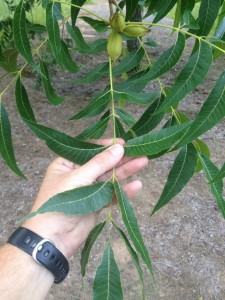Leaf sampling is the most important tool pecan growers have for determining their fertility needs. While soil samples are helpful for checking soil pH and determining any potential problems with competitive uptake between nutrients in the soil, leaf samples tell you the fertility status of the actual trees. Using soil and leaf samples together allows growers to match their fertilizer applications with the actual needs of the tree rather than just shooting in the dark. This provides an excellent opportunity to save a lot of money on fertilizer cost.
The general recommended period for leaf sampling is July 7-August 7. I would shift these dates by about 1 week this year since crop development is running 7-10 days behind normal. Why does it matter when you sample?Concentrations of N, P, and Zn on a leaf dry weight basis start off relatively high early in the season, decline rapidly, reach a fairly steady state after mid-June, and then decline near leaf fall. K tends to start high, then decreases and plateaus at about the same time as N, P, and Zn. Most of the P and Zn that accumulates in the leaves have done so by the time the leaves reach full size. Calcium (Ca) accumulates in the leaves as the season progresses, peaking in August-September. Magnesium (Mg) Manganese (Mn), and Boron (B) also tend to increase as the season progresses, but to a lesser extent than Ca.
Some growers have started taking leaf samples throughout the growing season to try and determine the fertility needs of the tree. This is really unnecessary and only an added cost. Leaf analysis does not necessarily reflect the actual use pattern of mineral nutrients. They merely indicate concentrations of those elements in the leaf at the time of sampling. The tree knows what it needs and when it needs it.
Concentrations of mineral nutrients in the leaves change as leaves emerge, expand, and finally senesce in the fall. For many elements, the least change in concentration occurs from early July-early August. Leaf samples should be taken at this time because critical levels established through experimentation and observation are based on sampling done during this period. Comparison of problem trees with healthy trees, can be done by leaf sampling at any time, providing one is aware of how element concentrations change during the season.
So, how should you take leaf samples?
- Collect 50- 100 middle-pair of leaflets from the middle leaf of this year’s growth (See figure above). Use terminal shoots exposed to the sun. Avoid twigs from the interior of the tree. Collect leaflets from all sides of the tree. Avoid leaflets damaged by insects and diseases.
- Abnormal trees or trees not representative of the area should be sampled separately. A complete and accurate description of abnormalities should accompany such samples.
- Sample trees of the predominant variety in a given block. If Schley is the main variety, sample Schley; if Stuart is the main variety, then sample Stuart, etc.
- Immediately upon collection, wipe leaves (entire surface, both top and bottom) with a damp cellulose sponge or cheese cloth to remove dust and spray residue. Do not allow the leaves to come into contact with rubber or galvanized containers. Partially air dry and place in the large envelope of the mailing kit.
- If recent soil test data is not available, it would be advisable to collect a soil sample and have it sent to a soil testing laboratory. By sampling the same trees each year, growers can more readily see the results of any changes to their nutritional programs.



